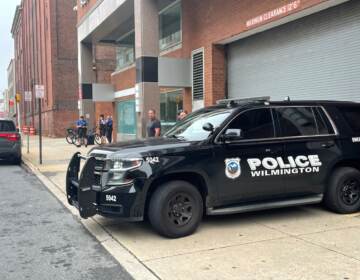Report: Slain Delaware prison guard warned about dangers days before February riot
A warning from a Delaware correctional officer just 12 days before he was killed in a February prison riot could have prevented the incident and his own death, according to an independent review ordered by Gov. John Carney.
The 159-page report released Friday about the uprising at the James T. Vaughn Correctional Center in Smyrna said Lt. Steven Floyd and other guards warned prison officials on January 20 that certain inmates should not have been in C-Building.
“Most unfortunately, the Independent Review Team believes that had the request for the removal of certain inmates from the C-Building — made on January 20, 2017 by the very correctional officer who was killed during the incident that began on February 1, 2017 — been taken more seriously and carried out, the incident and the resulting death may not have occurred,” the report said.
A footnote to the report noted that “due to the ongoing internal affairs investigation, the probe was “not able to determine whether steps were taken to address Sgt. Floyd’s request to remove certain inmates from C-Building.”
But Charles M. Oberly III, former U.S. attorney and attorney general for Delaware, who oversaw the independent investigation with retired Family Court Judge William L. Chapman Jr., said Friday that it appears Floyd’s warnings went unheeded.
“Officer Floyd did recognize that there were individuals that he thought should be removed … and as far as we can determine his requests were not acted on,” Oberly said during a news conference with Carney. “Had it been acted upon, or had [Floyd] been moved from that building — we use the word ‘may’, we can’t make the definite conclusion — but his death may have been avoided.”
Neither the report, nor Oberly or Carney, identified the inmates targeted for removal. Nor did they say whether those inmates were part of the group that took guards and other inmates hostage.
The review faced limitations such as not having access to police investigative reports, Department of Correction Internal Affairs reports and other documents involved in the ongoing criminal investigation. That is because authorities did not want to jeopardize any potential prosecutions, the report said. Attorney General Matt Denn’s office has said that officials expect grand jury indictments by early November.
The report details the circumstances that led prisoners to take over C-Building and hold correctional officers, prison staff and other inmates hostage. Lt. Floyd was killed at some point during the 20-hour standoff and two other correctional officers were injured. Floyd was a sergeant at the time and was posthumously promoted to lieutenant.
The report repeated and expanded on many of the findings of a preliminary report released June 2, and included dozens of recommendations to improve the conditions and prevent another catastrophe. The report’s key finding, however, was that conditions that led to the deadly siege had been building and stemmed in large part from a dysfunctional, adversarial culture between prison leaders and rank-and-file, and between staff and inmates, saying that in some areas conditions have worsened since the riot.
Correctional employees were and continue to be unhappy with working conditions, which included low pay, long hours and officers being frozen in place even at the end of their shift. Inmates have long been upset about a lack of consistency in the enforcement of rules by correctional officers.
“Conditions at the JTVCC had deteriorated to the point that there was unrest among inmates, and distrust between inmates and correctional officers, as well as between correctional officers and JTVCC administrators,” the report said.
Other factors “giving rise to this unrest,” the report said, included “an inmate grievance procedure deemed unfair, a distrusted medical/mental health system, and a real lack of morale permeating the line officers.”
Said Oberly: “We had several inmates tell us, ‘If they would just enforce the rules equally, it wouldn’t be as bad.'”
He added that some guards were lenient while others, such as Floyd, were tougher.
“He followed the rules, he was strict,” Oberly said.
The state has already made changes, such as improving security and pay for correctional officers, but the report makes clear that troubling and potentially dangerous conditions remain at Delaware’s largest prison.In June, the General Assembly approved spending $16 million to fund salary increases for correctional officers across the board, plus $2.3 million to add new positions. A labor-management committee was created to examine officer recruitment and retention, use of mandatory overtime, changing to 12-hour shifts, and revising the ‘freeze’ policy.
Through interviews with guards and inmates, there was one clear area of agreement: inmates need more programs to occupy their time while behind bars. “It’s not looked upon favorably by the General Assembly or the public. They don’t want to give prisoners things to do,” Oberly said. “But to a person, guards and inmates said, ‘Just give us something to do. Don’t have us just sit here 23 hours a day without anything to do.'”
Carney agreed with the need for more programs for inmates. “Ninety percent or more of the people behind bars are coming back out … You want those folks once they’re coming back to be in a more productive space then when they went in,” Carney said. “We just have to do a better job. Is it going to cost more money? Yes it will.”
Rev. Christopher Bullock, who heads the Delaware Coalition for Prison Reform and Justice, doubt this report will bring about any real change behind bars. “Often you can determine what’s going to happen in the future based on past behavior,” said Bullock, former president of New Castle County Council. “So in that regard, I’m not hopeful, but I’d love to be surprised.”
Bullock pointed to the inconsistency in the way officers enforced rules as a sign of a lack of leadership.
“You can’t have two separate sets of standards and expect to get a positive outcome. If indeed Mr. Floyd was more strict and others were more lenient then again, that speaks to the crisis in leadership, culture, training, authority, vision or lack thereof. ”
Jan. 15 incident prompted call to remove inmates
Within C-Building, a medium-high security unit designed for a maximum of prisoners that usually holds about 125, there existed “an environment vulnerable to violence,” the report said.
A major sign that serious trouble was brewing came on Jan. 15 — two weeks before the fatal uprising, the report said.
That day, inmates on the A and B tiers of the three-tier building “refused to return to their cells after recreation until they spoke with a supervisor regarding the conditions” in the building, the report said. The event was “peacefully resolved by supervisory staff,” but in the following days Floyd and other guards “identified inmates that they believed were primarily responsible” for the protest.
Those guards, including Floyd, “notified their supervisors that those inmates should be removed — at least temporarily — from the C-Building for security purposes.” Other supervisors at Vaughn supported moving those inmates but based on an email from then-Warden David Pierce, it appears that some Vaughn leaders “believed that the inmates’ disciplinary records did not support their transfer to the Security Housing Unit” known as SHU. Pierce was later placed on paid leave and reassigned.
So while the targeted inmates remained in C-Building, supervisors “informed higher level administrators about the tension brewing in C-Building and informed them that something needed to be done. Unfortunately, those supervisor’s concerns were dismissed,” the report said. The inaction “may have directly contributed” to the uprising.
While the inmates stayed in building and tensions grew, some guards and supervisors “felt that if the issue remained unaddressed, something else was going to happen in C-Building.”
Another potential factor was a November 2016 email from a prison administrator after a lawsuit settlement with the Community Legal Aid Society. The memo instituted a temporary policy change “that resulted, among other changes, in increased recreational time for those held in solitary confinement, including for inmates suffering from mental illness. The changes also pertained to restrictive housing units and inmate recreation schedules.”
Different facilities in the Department of Correction interpreted the email differently, but at Vaughn the result was that inmates in C-Building, which contains a mix of inmates moving up or down in security levels, felt they now had “considerable leverage not to follow instructions, further angering officers who already felt that they were not supported at the highest levels,” the report said.
That led to Floyd, who was in charge of his shift at C-Building, being directed by Vaughn administrators “to interpret the policy change as requiring all inmates to participate in recreation at the same time, instead of limiting recreation to one tier at a time in order to control movement,” the report said.
That decision backfired on Feb. 1, when the 127 inmates in C-Building were sent out of their cells to have recreational time. Most went outside, but others took showers, made phone calls or participated in other activities outside their cells.
Three guards oversaw indoor recreation and one was outside while a counselor stayed in her office on the unit. When those outside were called back inside about 10:30, a group of them “seized control of the building,” leading to the fatal siege.
The report includes a number of recommendations designed to improve communication among prison workers and improve conditions for inmates. The report calls for the state to decrease the inmate population and encourage alternatives to incarceration.
Rev. Bullock reiterated that the final report, just like the preliminary one, lacked a focus on the mistreatment of inmates.
“There was not a lot of attention given to the neglect and alleged abuse of the inmates, and this will not go away. We’re still getting letters, we’re still getting calls,” Bullock said of inmates who reached out to his coalition and described actions of correction officers. He said he gave several letters to the investigators and he was interviewed by the group for an hour and a half. “I gave them the truth, and again, it is not indicated in the report.”
Bullock said his coalition will work to keep attention on this issue now that the report has been issued, but called on lawmakers to do the same.
“We need legislators who care about people, who care about corrections, who care about reform, who care about the uplift of most of those who are incarcerated will come out. So we need to continue to invest in programs that will rehabilitate, and not just warehouse. And the inmates must want to change, and the state must provide the necessary programming for them to come out as assets to society and not liabilities.”
WHYY is your source for fact-based, in-depth journalism and information. As a nonprofit organization, we rely on financial support from readers like you. Please give today.




